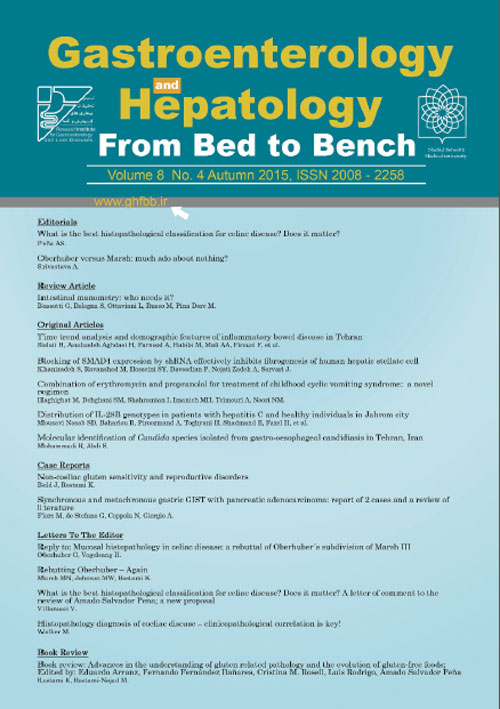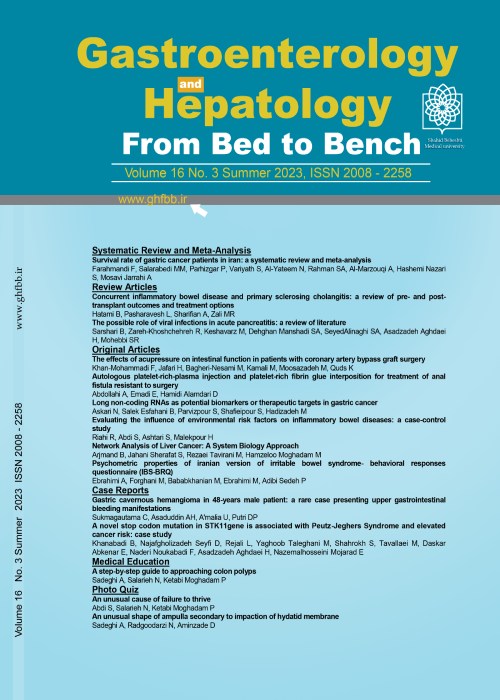فهرست مطالب

Gastroenterology and Hepatology From Bed to Bench Journal
Volume:8 Issue: 4, Autumn 2015
- تاریخ انتشار: 1394/07/10
- تعداد عناوین: 16
-
-
Page 246The use of manometry, i.e. the recording of pressures within hollow viscera, after being successfully applied to the study of esophageal and anorectal motor dysfunctions, has also been used to investigate physiological and pathological conditions of the small bowel. By means of this technique, it has been possible to understand better the normal motor functions of the small intestine, and their relationship and variations following physiologic events, such as food ingestion. Moreover, intestinal manometry has proved useful to document motor abnormalities of the small bowel, although recognition of altered patterns specific for a determinate pathologic condition is still unavailable. However, this technique often permits the detection of abnormal gut motility in patients with abdominal symptoms such as unexplained vomiting and diarrhea, and it is sometimes also useful to address therapeutic targeting.Keywords: Intestinal, Manometry, Motility, Myopathy, Neuropathy
-
Page 253AimThis retrospective study is aimed to review demographic and clinical characteristics of IBD to elucidate the probable factors associating with IBD development in Taleghani Hospital in Iran since 200 during a 12-year-period.BackgroundUlcerative colitis (UC) and Crohn’s disease (CD) are two major idiopathic entities of inflammatory bowel disease (IBD). Previous studies have reported an increased incidence of IBD in Middle East countries. Patients andMethodsIn the present study 1914 patients with UC, 318 patients with CD and 25 with indeterminate colitis (IC) were included. Demographic information, clinical features, extraintestinal manifestations, complications and extension of disease were collected and interpreted for all participants. According to the time of registration, patients were divided into seven groups. Statistical analysis was performed using the chi-square test.ResultsIn seven groups of IBD patients, disease registry was estimated for UC, CD, and total IBD during a 12-year-period. From 2001 to 2005, a relative increased registry was observed among UC patients. However, in the years 2006 and 2007 a significant reduction in the number of patients was reported. Then an increasing trend was observed in UC patients. UC presented mostly with diarrhea, hematochezia and bloody diarrhea, while most of CD patients complained of abdominal pain.ConclusionEvaluation of data related to registered IBD patients in Iran shows that probable incidence and prevalence of IBD (UC and CD) is increasing compared to previous decades.Keywords: IBD, Ulcerative colitis, Crohn's disease, Iran
-
Page 262AimIn this study, to clarify the SMAD4 blocking impact on fibrosis process, we investigated its down-regulation by shRNA on activated human LX-2 cell, in vitro.BackgroundLiver fibrosis is a critical consequence of chronic damage to the liver that can progress toward advanced diseases, liver cirrhosis and hepatocellular carcinoma (HCC). Different SMAD proteins play as major mediators in the fibrogenesis activity of hepatic stellate cells through TGF-β pathways, but the extent of SMAD4 as a co-SMAD protein remained less clear. Patients andMethodsvector expressing verified shRNA targeting human SMAD4 gene was transfected into LX-2 cells. The GFP expressing plasmid was transfected in the same manner as a control group while leptin treated cells were employed as positive controls. Subsequently, total RNA was extracted and real-time PCR was performed to measure the mRNA levels of SMAD4, COL-1A1, α-SMA, TGF-β and TIMP-1. Furthermore, trypan blue exclusion was performed to test the effect of plasmid transfection and SMAD4 shutting-down on cellular viability.ResultsThe results indicated that the expression of SMAD4was down-regulated following shRNA transfection intoLX- 2 cells (P<0.001). The gene expression analysis of fibrotic genes in LX-2 cells showed that SMAD4 blocking by shRNA significantly reduced the expression level of fibrotic genes when compared to control plasmids (P<0.001). Vector expressing SMAD4-shRNA induced no significant cytotoxic or proliferative effects on LX-2 cells as determined by viability assay (P<0.05).ConclusionThe results of this study suggested that knockdown of SMAD4 expression in stellate cell can control the progression of fibrogenesis through TGF-β pathway blocking.Keywords: SMAD4, Liver fibrosis, shRNA, Hepatic stellate cell
-
Page 270AimThis study aimed to evaluate the erythromycin efficacy in childhood cyclic vomiting syndrome.BackgroundCyclic vomiting syndrome (CVS) is an unusual cause of episodic emesis in children and erythromycin is an effective treatment.Patients andMethodsIn this prospective study, 301 patients with a final diagnosis of CVS enrolled in two separated groups. The first group received erythromycin for 7 days and propranolol for at least 9 months (n=155). The second group was treated with propranolol alone for at least 9 months (n=146). These two groups were compared for response to the treatment and the recurrence of symptoms after treatment completion. Relationship of response, recurrence, and characteristics of the disease was assessed.ResultsBoth groups showed a significant difference in terms of response to treatment (P=0.002), however the recurrence after treatment completion had no considerable difference (P=0.563). There was no relationship between CVS characteristics and these two items (response and recurrence).ConclusionIn our point of view, the addition of erythromycin to standard propranolol treatment can improve the response to treatment, although it has no significant effect on recurrence of CVS symptoms. We suggest the use of erythromycin for 7 days in addition to CVS standard therapy.Keywords: Erythromycin, Propranolol, Cyclic Vomiting Syndrome, Therapy
-
Distribution of IL-28B genotypes in patients with hepatitis C and healthy individuals in Jahrom cityPage 278AimThe purpose of this study was to compare the distribution of interleukin (IL)-28B genotypes between Iranian healthy individuals and patients with chronic hepatitis C based on the genotype.BackgroundPolymorphisms in the region of IL-28B gene have been identified as the strongest genetic pretreatment predictor of sustained virological response (SVR) in hepatitis C infection.Patients andMethodsIn this study, 147 patients with chronic hepatitis C and 80 healthy individuals were included. The IL-28B rs12979860 and rs8099917 polymorphisms were genotyped by PCR-RFLP method and the frequency of IL-28B polymorphisms with respect to HCV genotypes was also determined.ResultsThe frequencies of rs12979860 TT, CC and CT genotypes in the chronic hepatitis C patients and healthy individuals were as follows: 10.8% vs. 11.3%, 38.7% vs. 46.2% and 50.3% vs. 42.5%. Also, the frequencies of rs8099917 TT, GG and GT genotypes in the chronic hepatitis C patients was 61.9%, 6.1% and 32% and in controls was 47.5%, 11.2% and 41.3%. The differences in the distribution of rs12979860 genotypes and alleles between HCV genotype 1 and HCV genotype 3a infected patients were statistically significant.ConclusionThe rs12979860 C allele is the favorable allele for the spontaneous clearance of HCV. It seems that the impact of IL-28B polymorphism on the spontaneous clearance of HCV genotype 3 is more prominent than HCV genotype 1, which results in the observation of higher rs12979860 C allele frequency in chronic hepatitis C patients with HCV genotype 3 than HCV genotype 1.Keywords: Polymorphism, Hepatitis C, IL, 28B Genotype, Jahrom
-
Page 288AimThe aim of this investigation is identification of Candida strains isolated from patients with gastro-oesophageal candidiasis in Tehran, Iran.BackgroundGastro-oesophageal candidiasis is a rare infection and appears mainly in debilitated or immunocompromised patients. Colonization by Candida spp. may occur in this region and the organism can remain for several months or years in the absence of inflammation. The main infection symptom is the presence of white plaques in gastro-oesophageal surface. C. albicans remains the most prevalent Candida spp. identified in gastrointestinal candidiasis. Regarding differences in susceptibilities to antifungal drugs among Candida spp., identification of isolates to the species level is significant to quick and appropriate therapy.Patients andMethodsA total of 398 patients underwent gastrointestinal endoscopy during February 2012 to October 2014 were included in the present study. Histological sections from all endoscopic gastric and oesophageal biopsies were prepared, stained with Periodic acid–Schiff (PAS), and examined for the presence of fungal elements. Part of the biopsy sample was sub-cultured on sabouraud glucose agar. The genomic DNA of each strain was extracted using FTA® Elute MicroCards. Molecular identification of Candida isolates was performed by PCR-RFLP technique with the restriction enzyme HpaII.ResultsTwenty-one out of 398 cases (5.2%) were found to have gastro-oesophageal candidiasis. Candida albicans was the main strain isolated from clinical samples (90.5%), followed by C. glabrata (4.7%), and C. parapsilosis (4.7%).ConclusionDue to varying antifungal susceptibility of Candida spp. careful species designation for clinical isolates of Candida was recommended by a rapid and meticulous method like PCR-RFLP.Keywords: Candida species, Gastro, oesophageal candidiasis, PCR, RFLP
-
Page 294An association between coeliac disease and fertility disorders is well recognised in the current literature, but the information related to non-coeliac gluten sensitivity (NCGS) and infertility is lacking. This case highlights a possible role of treating NCGS in the reversal of infertility.Keywords: Irritable bowel syndrome, Non, celiac gluten sensitivity, Infertility, Reproductive disorders, Gluten
-
Page 298We report two cases of a gastrointestinal stromal tumor (GIST) synchronous and metachronous, respectively, with pancreatic adenocarcinoma. To our knowledge, this is the first report of a GIST involved 3 years after a ductal pancreatic adenocarcinoma. Data from the literature and our cases seem to suggest that incidental GIST may occur synchronously and metachronously with other cancers more frequently than expected. Thus, the patients with a diagnosis of pancreatic adenocarcinoma may have undergone a strict follow up for GISTKeywords: GIST, Pancreatic adenocarcinoma, Synchronous cancer, Metachronus cancer
-
Page 303


